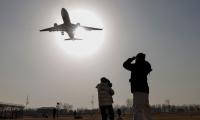Islamabad:After three days of a "curfew-like" lockdown, residents of Rawalpindi and Islamabad finally breathed a sigh of relief as the authorities reopened majority of the cities' entry and exit points. The suspended Metro Bus Service (MBS) resumed, and mobile services, which had been cut off, were also restored on Sunday.
Residents of the twin cities have expressed deep frustration with the recurring situation that has turned Rawalpindi and Islamabad into hotspots for protest demonstrations, sit-ins, and clashes between protesters and law enforcement. The cities, once known for their peaceful atmosphere and natural beauty, are now frequently paralysed by road blockages, security lockdowns, and communication blackouts. The Faizabad Interchange, a key junction between the two cities, has become an infamous protest site, often occupied for weeks at a time, leaving citizens without any rescue or relief from the ensuing chaos. Residents fear this has become the new norm, with the government shutting down daily life in the twin cities whenever a protest occurs.
This time, life ground to a halt following a protest organized by the Pakistan Tehreek-e-Insaf (PTI) at D-Chowk, Islamabad. Authorities responded by sealing all entry and exit points, suspending mobile phone services, and deploying heavy security forces. The impact on residents was severe — public transport was suspended, schools and businesses were closed, and roads were deserted.
The Islamabad police confirmed that all facilitation centres and driving license offices were shut down due to the PTI demonstration. Metro bus services in Rawalpindi were halted, particularly affecting commuters between Saddar and IJ Principal Road, though limited operations continued between IJP Road and the Pak Secretariat. Tear gas was fired at PTI supporters as they clashed with police at various locations, including D-Chowk and Faizabad Interchange. Heavy machinery, including double-layered containers, was deployed to block key roads, including the Islamabad Expressway, turning Rawalpindi and Islamabad into a virtual battleground. More than 4,000 security personnel were deployed in Rawalpindi to maintain order, but their presence only underscored the city's tense atmosphere.
In a drastic move, trenches were reportedly dug along roads connecting Khyber Pakhtunkhwa to Punjab to prevent further escalation. Private schools in Rawalpindi and Islamabad remained closed, with the Islamabad Private School Association citing safety concerns and roadblocks as the reasons behind the shutdown. A two-day ban on pillion riding was also enforced in Rawalpindi and Attock under Section 144. While public sector offices were technically open, they were without staff. Hospitals, though operational, were unreachable for many patients, including those with critical needs, due to the blocked roads and absence of transport. Businesses, petrol stations, and even public parks were deserted, while profiteers took advantage of the chaos, inflating prices and exploiting the situation.
Residents expressed outrage, accusing the federal and Punjab governments of turning a blind eye to their suffering. The recurring protests and the government's heavy-handed security responses have left citizens questioning how long they will have to endure such disruptions. The once tranquil cities of Rawalpindi and Islamabad now seem to be synonymous with protest chaos, leaving their residents caught in the crossfire between political dissent and state enforcement.
Federal Minister for Education and Professional Training Dr Khalid Maqbool Siddiqui chairs a meeting on March 20,...
A representational image showing traffic police official interacting with a citizen. — PunjabTrafficPolice...
The picture shows students walking towards their school. — Online/FileIslamabad: Parents have complained about...
A delegation of prominent business leaders of twin cities of Islamabad and Rawalpindi led by Sardar Yasir Ilyas Khan ...
Ambassador Masood Khan addresses an event on June 15, 2024. — X@Masood__KhanIslamabad: Masood Khan, former President...
Rwandan Ambassador Fatou Harerimana in a meeting with Prime Minister's Coordinator for Climate Change Romina Khurshid...







